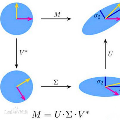PDE solutions are numerically represented by basis functions. Classical methods employ pre-defined bases that encode minimum desired PDE properties, which naturally cause redundant computations. What are the best bases to numerically represent PDE solutions? From the analytical perspective, the Kolmogorov $n$-width is a popular criterion for selecting representative basis functions. From the Bayesian computation perspective, the concept of optimality selects the modes that, when known, minimize the variance of the conditional distribution of the rest of the solution. We show that these two definitions of optimality are equivalent. Numerically, both criteria reduce to solving a Singular Value Decomposition (SVD), a procedure that can be made numerically efficient through randomized sampling. We demonstrate computationally the effectiveness of the basis functions so obtained on several linear and nonlinear problems. In all cases, the optimal accuracy is achieved with a small set of basis functions.
翻译:暂无翻译



